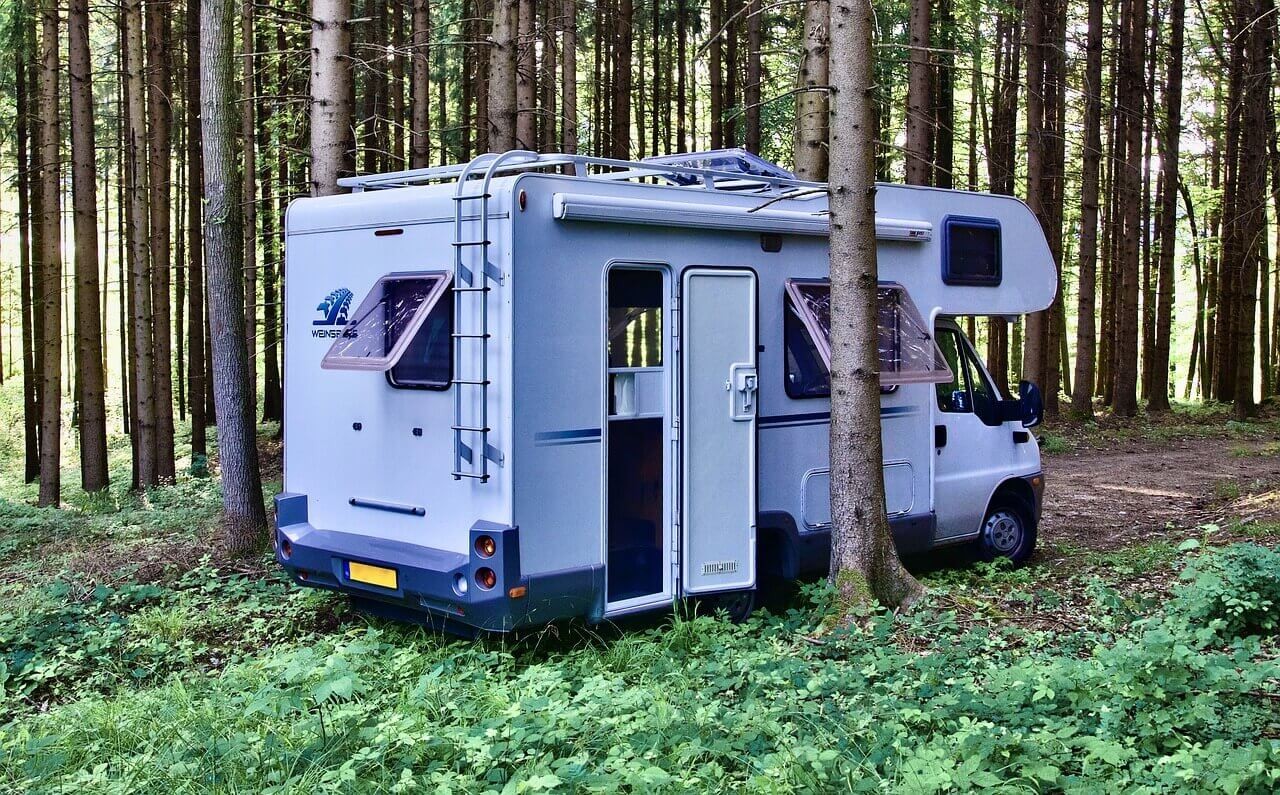
What is a Campervan, exactly?
A campervan, also known as a camper, is a van that has been modified to allow for both driving and sleeping. This means that you can not only drive your van from day to day, but you can also sleep in it at night when you park it (or for your midday post-hike naps). They're similar to RVs, but they're usually a lot smaller and easier to manoeuvre! Many campervans also include kitchen areas, toilets/showers, and ample storage space. For a long time, campervan road trips have been popular, especially in places like New Zealand and Australia. However, renting a camper van for a United States road trip to visit the National Parks has become increasingly popular in recent years.
Why Rent a Campervan?
Renting a campervan is, in my opinion, the best way to see North America, particularly if you're visiting the US National Parks. It will save you money on hotels and lodging, and it may also save you money on eating out because you can prepare your own meals in the van. Renting a campervan, on the other hand, is about much more than possibly saving money. One of my favourite things to do is go on a campervan road trip because you get to travel and see so much. But you also get to take your home – or, in the case of Cabana Vans, a hotel on wheels – with you wherever you go!
For example, many of the parks and hikes we visited on our road trip required us to arrive very early in order to gain access (or to get a parking spot). This can necessitate arriving up to an hour before a parking lot opens simply to sit and wait. When you can snooze your alarm in bed or make breakfast, sitting and waiting is a whole lot better!
A campervan road trip is a safe way to travel that allows you to see far more than a traditional road trip with hotel accommodations. It's also more adaptable than traditional campsites because no amenities are required (or have to hike into a primitive camping spots).
How to Choose a Campervan
A number of factors, including price range, location, and preferred amenities, will influence which campervan rental company you choose.
Cabana Vans is a great option if you're starting and ending your trip in Los Angeles, San Francisco, or Seattle.
The size of your group is another factor to consider when deciding which campervan company to book with. Some vans can only fit two people, a driver and a passenger, while others can accommodate up to 4-5 people. These vans frequently have a bed inside as well as a pop-up tent on top of the vehicle. Native Campervans and Escape Campervans are two other companies to look into if Cabana Vans isn't available in your area. The cost per day of each of these van rentals will obviously vary depending on the amenities provided.
Choosing a Campground for your Campervan Road Trip
The advantage of a campervan road trip over a regular road trip is that you can park your van wherever overnight parking is permitted. You don't need campground amenities like restrooms or showers because you have everything you need in your van.
The Dyrt
The Dyrt is a free app with a paid version that assists you in finding campgrounds. Everything from established campsites and RV parks to BLM sites and dispersed campsites can be found on their app.
BLM Land
The Bureau of Land Management (BLM) provides a variety of camping options, ranging from extremely primitive free camping to more established campgrounds. Almost all BLM sites are first-come, first-served, but fees vary by location. The BLM website has more information.
National Parks and State Parks
If you visit any of the United States' National Parks or State Parks, you'll find that the parks often have their own campgrounds. Many of these are either first-come, first-served, or have long waiting lists. The Zion campgrounds, for example, open new slots exactly two weeks before they close, and spots frequently sell out in minutes.
Most National Park campgrounds charge a fee, which ranges from $20 to $35 USD but can reach $50 USD in some cases. However, the convenience of staying within the park comes at a price. This will save you a lot of time and allow you to get to those amazing sunrise spots without having to get up as early.
Tips for a Campervan Road Trip
Learn how to empty any type of waste.
If your van has a sink or toilet, or even just running water, you'll need to learn how to empty the waste if you're going on a trip longer than a day or two. If you've never done anything like this before, it can be intimidating, but I promise it's not difficult. You'll be in a better position than I was the first time if you understand the basic logistics of how waste is emptied from vans. Let's just say the season RVers cracked a few jokes about us.
Regardless of which van company you rent from, they should have a detailed guide on how and where to dump. Simply make sure you have the correct guide for your van and that you download any instructions ahead of time, as you may not have cell service when it's time to dump.
It's also crucial to know where to dump. It is illegal to dispose of your waste, particularly black water from the toilet, at a location that is not designated as a black water dumping station. Dumping stations are available at most RV parks and established campgrounds. If you have a reservation at the site, they are frequently available for overnight guests. Otherwise, a small fee, usually less than $10, may be charged to fill up your van with freshwater and dispose of any black water or grey water waste.
Don’t Overpack
Even though many vans, such as Cabana Vans, have closets and plenty of storage space, it's still a good idea not to overpack. Remember, you'll be eating, sleeping, and driving in the same space, so make it as uncluttered as possible. Shoes are the most space-consuming item in the van, as they are more difficult to store once they are dirty. I recommend being very selective about what you pack and not bringing that fourth pair of shoes or the millionth pair of leggings that you know you're not going to wear.
Turn off Electronics and Lights When Not in Use
The majority of van rental options get their battery power from one of two sources: solar power or running the van's engine. This means you'll need to make sure you have enough battery for whatever you need to do at night. If you drive every day, a dead battery should not be an issue for you. If you plan on staying in one place for a few days, however, you may need to be more cautious with your battery usage. Bringing along battery-operated fairy lights is a great way to get some light while also conserving electricity. Even if battery conservation isn't a priority for you, stringing some fairy lights is still a great way to create a festive atmosphere. Definitely a must-have for your next road trip in a campervan.
Download an Offline Map
I always recommend downloading the offline maps for any areas you plan on visiting before going on a road trip. For me, the pre-downloaded offline Google Map works perfectly! Also, take a look at maps.me.
Make Sure to Pack the Essentials
If you're going on a campervan road trip, there are a few things you'll want to remember to bring. I've got a full list of the top ten things to bring,' but here are a few essentials to remember:
First Aid Kit:
Make sure you have the basics, such as bandages, antibacterial cream, allergy medicine, and any other Western medications you take on a regular basis.
Cooking Essentials:
Booking a van with a kitchen or a kitchen add-on option is highly recommended. If that's the case, make sure you have any cooking necessities on hand, such as a sharp knife, small cutting board, basic spices, tupperware/Stasher bags, and cutlery. Every day, we also used our Stojo cups and bowls, which are ideal for meals in the van, packed lunches, and simply storing food.
Comfy Shoes:
Bring a pair of comfortable shoes, such as slippers or flip flops. This will allow you to remove your hiking boots in the evening and allow your feet to relax. For getting in and out of the van, I recommend something that is easy to slip on. Plus, if you're using public showers at a campground, flip flops are always a good idea.
Choose the Right Campground for Your Needs
As I previously stated, there are a variety of campgrounds where you can stay. Your personal travel style and preferences will influence how you choose where to stay. We were able to be relatively self-sufficient by renting a Cabana Van, but we did need to fill up on fresh water and empty our waste a few times. Showers at the campground are also useful; using the van shower is a luxury, but it quickly depletes the water tank if you aren't connected to water.
We only reserved two campgrounds ahead of time for our 10-day road trip, and two more while on the road. The remaining spots were available on a first-come, first-served basis, and were either paid or unpaid. We reserved ahead of time either through the National Parks website, such as HipCamp for the Zion campground, or through a dedicated RV park website, such as KOA (like the one we stayed at in Monument Valley). We didn't want to take any chances with first-come, first-served spots because the exact location was so important to us on all of these nights. The off-the-beaten-path, free camping spots, on the other hand, were unquestionably our favourites. We discovered some truly magical free options in and around Sedona, Arizona and Moab, Utah.
Buy a National Parks Pass
If you're going on a campervan road trip in the United States, you'll need to purchase a National Parks Pass. Stop what you're doing and go out and buy one right now if you don't already have one! The America the Beautiful pass, which costs $80, grants access to all of the National Parks as well as a number of other parks. A single park entrance fee can easily cost $30, so the pass is well worth it even if your trip is only a few days long. It can also be assigned to two different users and is valid for a full calendar year.



